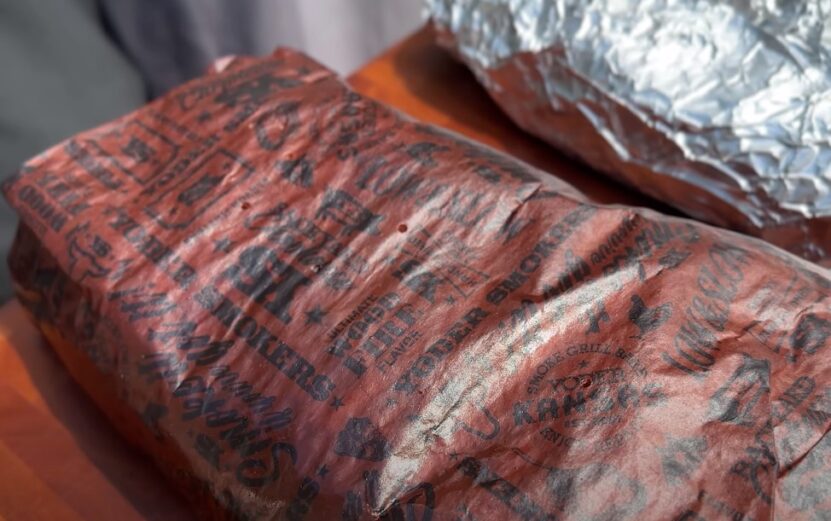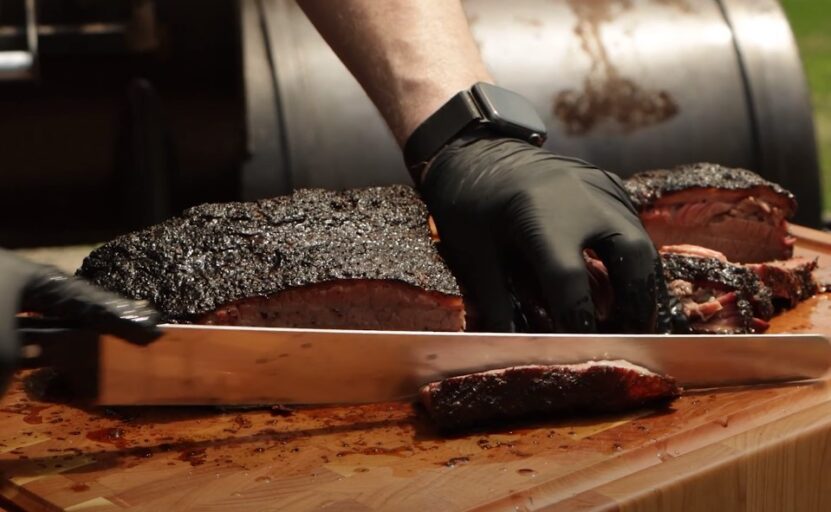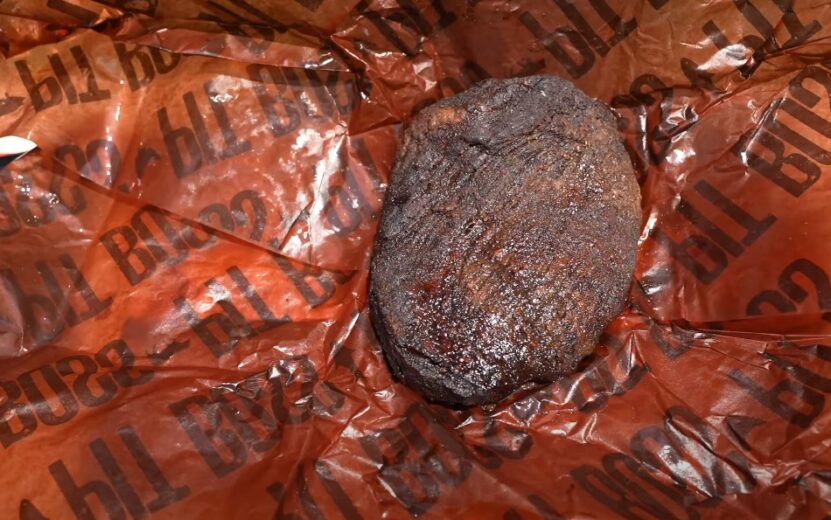Wrapping brisket, often referred to as the ‘Texas Crutch,’ serves several purposes. It helps to prevent the meat from drying out, speeds up the cooking process, and can reduce the harshness of the smoke flavor. There are two primary choices for wrapping: butcher paper or aluminum foil.
Butcher paper is breathable, allowing for a better smoke flavor and a firmer bark. Aluminum foil, on the other hand, traps more moisture and heat, speeding up the cooking process but potentially leading to a softer bark.
In this guide, we’ll explore the hows and whens of achieving that perfect melt-in-your-mouth texture and rich flavor.
The Right Time to Wrap
The ideal time to wrap your brisket is when it reaches an internal temperature of 150°F to 160°F. This is typically when the meat’s surface color is rich mahogany and the bark has started to form. Wrapping too early can result in a less flavorful bark while wrapping too late can lead to dryness.
Step-by-Step Wrapping Guide
- Remove the Brisket: Begin by donning heat-resistant gloves to ensure safety. Gently lift the meat from the smoker, being careful to preserve its shape and bark. The brisket will be extremely hot and potentially fragile at this stage, so a steady, careful approach is crucial.
- Prepare the Wrap: Select a sizeable piece of butcher paper or aluminum foil, ensuring it’s large enough to completely encompass the brisket. Spread it out on a clean, flat surface, smoothing out any creases or wrinkles. This preparation is vital to ensure a seamless wrap that doesn’t tear or come apart during the cooking process.
- Place the Brisket: With the wrap laid out, carefully place the meat in the center, positioning it fat side up. This orientation is important as it allows the fat to continue rendering down through the meat, enhancing flavor and moisture. Ensure the brisket is correctly aligned for an even wrap.
- Wrap Tightly: Begin by folding the edges of your chosen material over the brisket, starting with the longer sides and then the shorter ends. The wrap should be snug enough to hold in moisture and heat but not so tight that it compresses the meat or causes the juices to escape. Pay particular attention to corners and edges to ensure they are well-sealed.
- Return to the Smoker: Gently lift the wrapped brisket, supporting it from the bottom, and place it back in the smoker. Position it so that the seam of the wrap is facing upwards, which helps to prevent any juices from leaking out during the remainder of the cooking process. This step also marks the transition to the final phase of cooking, where the brisket will reach its tender, flavorful peak.
Finishing and Resting the Meat

Testing for Doneness
A perfectly cooked brisket isn’t just about temperature; it’s also about feel. Use a probe or a skewer to test the meat. It should glide in with little to no resistance, similar to inserting a skewer into room-temperature butter. This tactile test is often more reliable than temperature alone, as it gauges the tenderness and readiness of the brisket’s connective tissues.
Pay attention to the resistance in different parts of the meat, as thickness can vary. If the probe meets resistance in certain areas, consider extending the cooking time slightly for a more uniform tenderness.
The Importance of Resting
Resting the meat is crucial. This allows the juices to redistribute throughout the meat, resulting in a more tender and flavorful brisket. Rest it wrapped for at least one hour, or even longer if time permits. During this time, the meat continues to cook slightly, often referred to as ‘carry-over cooking,’ which can perfect its texture.
A good rule of thumb is to rest the brisket for at least 10% of its cooking time. Avoid the temptation to cut into the brisket too soon, as this can result in a significant loss of moisture and flavor.
Unwrapping and Slicing

After resting, carefully unwrap the brisket. Slice against the grain for the most tender eating experience. The thickness of the slices can vary based on preference, but a general guideline is pencil thickness.
Slicing against the grain shortens the muscle fibers, enhancing the meat’s tenderness and ease of chewing. For a clean cut, use a sharp, long knife and aim for smooth, even strokes. Serve the slices immediately to enjoy the brisket at its peak of flavor and texture, complemented by your favorite sides and sauces.
FAQs
Can I wrap my brisket in parchment paper instead of butcher paper or foil?
Yes, you can use parchment paper as an alternative to butcher paper or aluminum foil. Parchment paper is similar to butcher paper in that it’s breathable, which can help maintain a good bark on the meat.
However, it’s not as strong as butcher paper and might tear easily when handling a large brisket.
How do I know if my brisket is undercooked or overcooked?
An undercooked brisket will feel tough and will be difficult to slice. It won’t have the characteristic “pull-apart” tenderness. An overcooked piece, on the other hand, will be too mushy and may fall apart too easily, losing its texture.
It’s all about finding the balance between tenderness and retaining structure.
Is it necessary to season the brisket before wrapping?
Absolutely. Seasoning the meat before smoking is crucial for flavor development. The seasoning forms the basis of the bark and infuses the meat with flavors during the smoking process. The wrap then helps to lock in these flavors and moisture.
How does the thickness of the brisket affect cooking time?
The thicker the brisket, the longer it will take to cook. This is because the heat takes more time to penetrate and break down the connective tissues in thicker cuts. Always use a meat thermometer to gauge doneness rather than relying solely on cooking time.
Can I wrap my brisket midway through the smoking process if I notice it’s drying out?
Yes, you can. If you observe that the meat is drying out or the bark is forming too quickly, it’s perfectly fine to wrap it mid-smoke. This can help retain moisture and prevent the meat from becoming too dry.
What’s the best way to maintain the smoker’s temperature for brisket?
To maintain a consistent temperature in your smoker, regularly check your fuel supply, whether it’s charcoal, wood, or gas, and adjust accordingly. Also, avoid opening the smoker too often, as this can cause significant temperature fluctuations.
Using a smoker with a built-in thermometer or a digital meat thermometer with a remote monitor can help keep an eye on the temperature without opening the smoker.
Summary
In conclusion, wrapping a brisket is an essential technique in the smoking process, crucial for achieving the perfect balance of tenderness, moisture, and flavor. The key is to wrap the meat at the right time, typically when it reaches an internal temperature of 150°F to 160°F, and choose the appropriate wrapping material, like butcher paper or aluminum foil.
Always keep in mind that mastering this technique requires practice and patience, but the delicious results are well worth the effort. Follow these tips and tricks, and you’ll be on your way to smoking a brisket that’s sure to impress.
